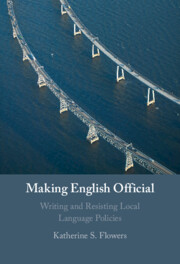Book contents
- Making English Official
- Making English Official
- Copyright page
- Dedication
- Contents
- Figures
- Tables
- Acknowledgments
- Introduction
- 1 The Origins of the English-Only Movement
- 2 Creating English-Only Policies
- 3 Emphasizing the Local in Language Policy
- 4 Resisting and Rewriting
- Conclusion
- Book part
- References
- Index
1 - The Origins of the English-Only Movement
Published online by Cambridge University Press: 04 January 2024
- Making English Official
- Making English Official
- Copyright page
- Dedication
- Contents
- Figures
- Tables
- Acknowledgments
- Introduction
- 1 The Origins of the English-Only Movement
- 2 Creating English-Only Policies
- 3 Emphasizing the Local in Language Policy
- 4 Resisting and Rewriting
- Conclusion
- Book part
- References
- Index
Summary
From the beginning, local language policies were crucial to the formation of the English-only movement. From the 1970s into the 1980s and 1990s, relatively disparate activists and politicians started to notice each other, collaborate with each other, and form English-only organizations together. To tell this story, I focus on the perspectives and experiences of key figures like Emmy Shafer, who started the current English-only movement in 1980 when she started organizing support for an Antibilingualism Ordinance targeting Spanish and Kreyòl in Dade County, Florida. Shafer pioneered a number of groundbreaking strategies that would become a blueprint, like emphasizing the local economy, starting a nonprofit, and hiring a ghostwriter. I also introduce the two figures who really popularized the idea of making English official: John Tanton and Senator S. I. Hayakawa. I discuss the founding of U.S. English and of English Language Advocates (later renamed ProEnglish). Ultimately, these people and organizations paved the way for the local language policies discussed in future chapters.
Keywords
- Type
- Chapter
- Information
- Making English OfficialWriting and Resisting Local Language Policies, pp. 29 - 60Publisher: Cambridge University PressPrint publication year: 2024

